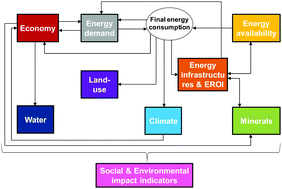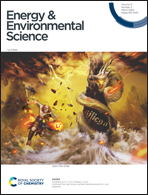MEDEAS: a new modeling framework integrating global biophysical and socioeconomic constraints†
Abstract
A diversity of integrated assessment models (IAMs) coexists due to the different approaches developed to deal with the complex interactions, high uncertainties and knowledge gaps within the environment and human societies. This paper describes the open-source MEDEAS modeling framework, which has been developed with the aim of informing decision-making to achieve the transition to sustainable energy systems with a focus on biophysical, economic, social and technological restrictions and tackling some of the limitations identified in the current IAMs. MEDEAS models include the following relevant characteristics: representation of biophysical constraints to energy availability; modeling of the mineral and energy investments for the energy transition, allowing a dynamic assessment of the potential mineral scarcities and computation of the net energy available to society; consistent representation of climate change damages with climate assessments by natural scientists; integration of detailed sectoral economic structure (input–output analysis) within a system dynamics approach; energy shifts driven by physical scarcity; and a rich set of socioeconomic and environmental impact indicators. The potentialities and novel insights that this framework brings are illustrated by the simulation of four variants of current trends with the MEDEAS-world model: the consideration of alternative plausible assumptions and methods, combined with the feedback-rich structure of the model, reveal dynamics and implications absent in classical models. Our results suggest that the continuation of current trends will drive significant biophysical scarcities and impacts which will most likely derive in regionalization (priority to security concerns and trade barriers), conflict, and ultimately, a severe global crisis which may lead to the collapse of our modern civilization. Despite depicting a much more worrying future than conventional projections of current trends, we however believe it is a more realistic counterfactual scenario that will allow the design of improved alternative sustainable pathways in future work.

- This article is part of the themed collection: Recent Open Access Articles


 Please wait while we load your content...
Please wait while we load your content...